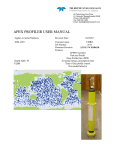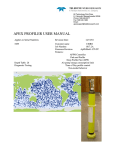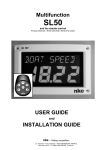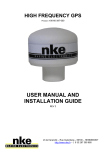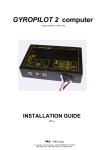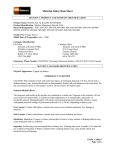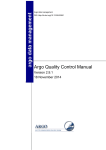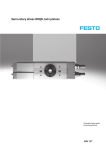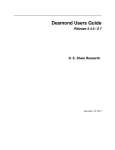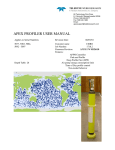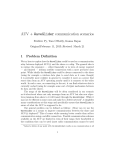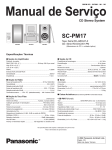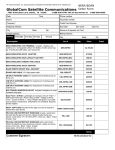Download USER MANUAL - Argo Information Centre
Transcript
ARVOR-I JAMSTEC USER MANUAL Z.I de KERANDRE - RUE GUTENBERG 56700 HENNEBONT - FRANCE Telephone: +33 (0)2 97 36 10 12 Fax: +33 (0)2 97 36 55 17 Web : http://www.nke.fr - E-mail : [email protected] USER MANUAL © nke: This document is the property of nke electronics and contains proprietary and confidential information. The document is loaned on the express condition that neither the document itself nor the information contained therein shall be disclosed without the express consent of nke electronics and that the information shall not be used by the recipient without prior written acceptance by nke electronics. Furthermore, the document shall be returned immediately to nke electronics upon request. DOC rev.1 du 18/07/11 ARVOR-I JAMSTEC USER MANUAL 1 INTRODUCTION ............................................................................................................................................................... 5 2 OPERATING INSTRUCTIONS ....................................................................................................................................... 6 2.1 HANDLING PRECAUTIONS .............................................................................................................................................. 6 2.2 ACCEPTANCE TESTS ...................................................................................................................................................... 6 2.2.1 Inventory................................................................................................................................................................... 6 2.2.2 Physical Inspection................................................................................................................................................... 6 2.3 DEFAULT PARAMETERS ................................................................................................................................................. 6 2.3.1 ARGO Identification ................................................................................................................................................. 6 2.3.2 Decoding .................................................................................................................................................................. 6 2.4 LAUNCHING ................................................................................................................................................................... 7 2.4.1 Test the Float and arm the mission .......................................................................................................................... 7 2.4.2 Remove protective plugs and magnet ....................................................................................................................... 7 2.4.3 Launch the Float ...................................................................................................................................................... 7 2.5 CHECKS PRIOR TO DEPLOYMENT .................................................................................................................................... 9 2.5.1 Necessary Equipment ............................................................................................................................................... 9 2.5.2 Connecting the PC.................................................................................................................................................... 9 2.5.3 Example of Bluetooth dongle tested by NKE .......................................................................................................... 11 2.5.4 How to Send Commands ........................................................................................................................................ 12 2.5.5 How to Read and change Parameter Values......................................................................................................... 12 2.5.6 How to Check and change the Time ....................................................................................................................... 13 2.5.7 Configuration Check .............................................................................................................................................. 14 2.5.8 Functional Tests ..................................................................................................................................................... 14 3 GENERAL DESCRIPTION OF ARVOR-I FLOAT ..................................................................................................... 15 3.1 ARVOR-I.................................................................................................................................................................... 15 3.1.1 Electronics .............................................................................................................................................................. 15 3.1.2 Embedded software ................................................................................................................................................ 15 3.2 HULL ........................................................................................................................................................................... 15 3.3 MAGNET POSITIONS..................................................................................................................................................... 16 3.4 DENSITY CONTROL SYSTEM ........................................................................................................................................ 18 3.5 SENSORS ...................................................................................................................................................................... 18 3.6 IRIDIUM/GPS MODEM ............................................................................................................................................ 18 3.7 CPU BOARD ................................................................................................................................................................ 18 3.8 BATTERY ..................................................................................................................................................................... 18 3.9 MMI LINK ................................................................................................................................................................... 18 4 THE LIFE OF AN ARVOR-I FLOAT ............................................................................................................................ 19 4.1 4.2 4.3 4.4 4.5 4.6 5 ARVOR-I PARAMETERS............................................................................................................................................... 23 5.1 6 THE MISSION - OVERVIEW ........................................................................................................................................... 19 DESCENT ..................................................................................................................................................................... 21 GROUNDING ................................................................................................................................................................ 21 SUBMERGED DRIFT ...................................................................................................................................................... 21 ASCENT ....................................................................................................................................................................... 21 TRANSMISSION ............................................................................................................................................................ 22 MISSION PARAMETERS ................................................................................................................................................ 24 IRIDIUM FORMATS ....................................................................................................................................................... 25 6.1 OVERVIEW ................................................................................................................................................................... 25 6.2 TECHNICAL MESSAGE .................................................................................................................................................. 26 6.3 SUBMERGED DRIFT CTD MESSAGE ............................................................................................................................. 28 6.4 ASCENT PROFILE CTD MESSAGE ................................................................................................................................. 28 6.4.1 Parameters Data message ...................................................................................................................................... 29 6.5 6.6 LIFE EXPIRY MESSAGE ................................................................................................................................................ 30 IRIDIUM COMMMANDS ................................................................................................................................................. 30 7 SPECIFICATIONS ........................................................................................................................................................... 31 8 ARVOR-I OPERATING PRINCIPLE ........................................................................................................................... 32 9 LITHIUM BATTERY....................................................................................................................................................... 33 10 GLOSSARY ....................................................................................................................................................................... 34 DATE REVISION OBJET Auteur 01/07/11 0 Creation JS 18/07/11 1 Parameters Data message(mission parameters) format modification (6.4.1) JS ARVOR-I JAMSTEC USER MANUAL WHITE PAGE / PAGE BLANCHE ARVOR-I JAMSTEC USER MANUAL 1 INTRODUCTION ARVOR-I is a subsurface profiling float developed jointly by IFREMER and MARTEC Group. Since January 1st, 2009 nke has integrated profiling floats activity and is now in charge of ARVOR-I manufacturing and development in industrial partnership with IFREMER. ARVOR-I is the successor of ARVOR, from which it takes up most of the essential sub-assemblies.. The ARVOR-I float described in this manual is designed for the ARGO Program. This international program will be a major component of the Global Ocean Observing System (GOOS). An array of 3,000 free-drifting profiling floats is planned for deployment in 2004. These floats will measure the temperature and salinity of the upper 2,000 meters of the ocean, allowing continuous monitoring of the ocean's climate. All Argo measurements will be relayed and made publicly available within hours after collection. The data will provide a quantitative description of the evolving state of the upper ocean and the patterns of ocean climate variability, including heat and freshwater storage and transport. It is expected that ARGO data will be used for initialization of ocean and coupled forecast models, and for dynamic model testing. A primary focus of Argo is seasonal to decadal climate variability and predictability. After launch, ARVOR-I 's mission consists of a repeating cycle of descent, submerged drift, ascent and data transmission. During these cycles, ARVOR-I dynamically controls its buoyancy with a hydraulic system. This hydraulic system adjusts the density of the float causing it to descend, ascend or hover at a constant depth in the ocean. The user selects the depth at which the system drifts between descent and ascent profiles. ARVOR-I continually samples the pressure at this drift depth and maintains that depth within approximately 30m. After the submerged drift portion of a cycle, the float proceeds to the depth at which the ascending profile is to begin. The ascent profile starting depth (typically the ARGO-selected depth of 2,000m) is not necessarily the same as the drift depth. During its mission, ARVOR-I collects measurements of three parameters - salinity, temperature and depth (CTD) - and saves them in its memory. These measurements can be made during the submerged drift period (Lagrangian operation) and during the ascent (ascent profile). After each ascent, ARVOR-I transmits its saved data to the satellites of the Iridium system. This manual describes the ARVOR-I float, how to use it and safety precautions to be observed during handling. Please read this manual carefully to ensure that ARVOR-I functions as intended. Overview of the present manual’s contents: Chapter 2 contains the instructions necessary for the personnel in charge of the deployment Chapter 3 describes the components of ARVOR-I -I; it is intended for those who want a more indepth understanding of ARVOR-I Chapter 4 describes the mission of ARVOR-I Chapter 5 describes the various parameters Chapter 6 describes the various Iridium messages Chapter 7 presents the technical specifications Chapter 8 provides explanations about the operation of ARVOR-I Chapter 9 specifies the elements of the constraints limited to the transport of Lithium batteries. 6/ ARVOR-I JAMSTEC USER MANUAL 2 OPERATING INSTRUCTIONS The following instructions tell you how to handle, configure, test and launch the ARVOR-I float. Please read these instructions carefully and follow them closely to ensure your ARVOR-I float functions as intended. 2.1 Handling Precautions ARVOR-I is designed to withstand submersion at great depths for long periods of time (up to five years). This remarkable specification in oceanographic instrumentation is possible thanks to the protection of the casing by an anti-corrosion coating. This coating is sensitive to impact. Damage to the coating can accelerate the corrosion process. NOTE: Take precautions to preserve the anti-corrosion coating during handling. Remove the float from its packing only when absolutely necessary. NOTE: Regulations state that ARVOR-I must not be switched on during transport. 2.2 Acceptance Tests Immediately upon receipt of the ARVOR-I float, you should test it to confirm that it is complete, correctly configured and has not been damaged in shipment. If your ARVOR-I float fails any of the following tests, you should contact nke electronics. 2.2.1 Inventory The following items should be supplied with your ARVOR-I float: • The present user manual. • A test sheet. NOTE: Disassembly of the float voids the warranty. Check that all of the above items are present. If any are missing, contact nke. 2.2.2 Physical Inspection Upon the opening of the transport casing, visually inspect the float's general condition: Inspect the transport container for dents, damage, signs of impact or other signs that the float has been mishandled during shipping. Inspect the CTD sensor, antenna, hull, housing around the lower bladder for dents or any other signs of damage NOTE: Ensure the magnet is in place against the hull (installed on ON/OFF Position). 2.3 Default Parameters Notwithstanding special instructions given to NKE during the ARVOR-I preparation stage, the following set of parameters is applied: section 5. page 23 If these parameters are not appropriate, the user can change them himself by following the instructions. 2.3.1 ARGO Identification The user is responsible for contacting the AIC in order to obtain the WMO number which will identify the ARVOR-I ’s mission 2.3.2 Decoding The CORIOLIS project team (IFREMER) is able to assist the teams that use ARVOR-I for data processing 7/ ARVOR-I JAMSTEC USER MANUAL 2.4 Launching Following is what you should do to launch the ARVOR-I float. 2.4.1 Test the Float and arm the mission Before you take ARVOR-I on deck for deployment, we recommend that you repeat all of the tests described in section 2.5 page 10. This will ensure that the float is functioning and configured correctly and maximize the probability of success of your experiment. IMPORTANT: Before launching the float, you must arm the mission by issuing the !AR command: !AR ARVOR-I will respond: <AR ON> Put the magnet on the float. NOTE: Once the mission is armed, the next time you will attempt to communicate with the float upon magnet removal, you need to press "ENTER" within 30 seconds (before the pump starts) in order to get the prompt ]. 2.4.2 Remove protective plugs and magnet The pump system of the CTD sensor is sealed by 3 protective plugs. Remove these plugs from the sensor before launching. Protective plugs CTD sensor Remove the magnet located near the top of the float (see Figure 1 – General view of ARVOR-I float 2: page 17). Retain the magnet for future use in case the float is recovered. ARVOR-I is now ready for launch. To confirm that the magnet has been removed and that the float is ready for launch, 5 seconds after magnet removal, ARVOR starts 5 valves actions. After 80s, the seabird pump is active. If you have water in the CTD, this water go out by the holes where was the protectives plugs. After 100 sec, floats starts 5 quick valve activations. NOTE: Once the magnet has been removed, the ARVOR-I float performs an initial test. Ensure that the pump starts as explained above before placing the float in the water. If you do not hear the valve running after 30 seconds, and you do not see the water after 90s, replace the magnet, connect the PC, and conduct the tests described in section 2.5. page 10. If these tests fail, contact nke technical support. 2.4.3 Launch the Float NOTE: Keep the float in its protective packaging for as long as possible to guard against any nicks and scratches that could occur during handling. Handle the float carefully, using soft, nonabrasive materials only. Do not lay the float on the deployment vessel's unprotected deck. Use cardboard or cloth to protect it. 2.4.3.1 By hand ARVOR-I can be launched by hand from the deck from a height of 3 meters 8/ ARVOR-I JAMSTEC USER MANUAL 2.4.3.2 Using a rope The damping disk is already fastened on the tube (under the buoyancy foam). It is possible to use the holes in the damping disk in order to handle and secure the float during deployment. Put the rope in the hole according to the following photo: Rope for launch with release system After the launch, you may decide to wait alongside the float until it starts its descent, but this can take up to 3 hours depending on the float’s buoyancy when it is placed in the water. 9/ ARVOR-I JAMSTEC USER MANUAL 2.5 Checks prior to deployment 2.5.1 Necessary Equipment The equipment required to check that ARVOR-I is functioning correctly and to prepare it for the mission are: (1) A PC. The most convenient way of communicating with ARVOR-I is with a PC in terminal emulation mode. Among other advantages, this allows storage of configuration parameters and commands. You can use any standard desktop or laptop computer. The PC must be equipped with a serial port (usually called COM1 or COM2). (2) VT52 or VT100 terminal emulation software. The Hyper Terminal emulation software can be used. (3) A Bluetooth Dongle with drivers installed on the PC (BELKIN class 2 model is recommended). 2.5.2 Connecting the PC Make sure you check the following points before attempting a connection: Bluetooth key connected to the PC with the drivers installed Magnet present at the Bluetooth’s power supply ILS (see Figure 1 – General view of ARVOR-I float : page 17) Start Hyperterminal after checking on which COM port the Bluetooth key is installed by going to: Control Panel->System-> click on Hardware tab->Device Manager as shown in the figure below: On the PC, run the following commands as shown in the figure below: Right click on the Bluetooth logo in the bottom right corner of the Desktop Select Quick Connect, Bluetooth Serial Port, then click on other devices 10/ ARVOR-I JAMSTEC USER MANUAL A window appears as shown in the figure below: Click on Refresh Check that the Bluetooth number is present on the traceability label (see Figure 1 – General view of ARVOR-I float 2: page 17) There are two ways of establishing the connection: Either select the number shown and press Connect Or come back to the previous step and instead of selecting “other devices”, select the number shown When the connection is made, a dialog box appears as shown in the figure above: 11/ ARVOR-I JAMSTEC USER MANUAL Double click on it and a window appears as shown below: Enter the security code “0000” You can now check the connection by double clicking on the Bluetooth logo in bottom right corner of the Desktop The “Bluetooth favourites” window appears: Use your PC's terminal emulation software to configure the selected serial port for: • 9,600 baud • 8 data bits • 1 stop bit • Parity: none • Full duplex • No flow control 2.5.3 Example of Bluetooth dongle tested by NKE USB Bluetooth™ adaptor - 100 meters, Part # F8T012fr Made by Belkin 12/ ARVOR-I JAMSTEC USER MANUAL 2.5.4 How to Send Commands You must communicate with ARVOR-I to verify or change its configuration parameters, to read data from the float, or to test the float's functions. You perform these verifications/changes by sending commands, and by observing the float's response to those commands. Compose commands by typing characters on the keyboard of your PC, and send them to ARVOR-I by pressing the Enter key. In the following descriptions of commands we will use the general syntax: • Keystrokes entered by the user are written in bold. • Replies received from the float are in normal font. • Commands entered by the user end with the Enter key. The software version can be viewed using the ?VL command ARVOR-I will respond: <VL 5606A02> <VC IRIDIUM> The float’s serial number can be viewed using the ?NS command ARVOR-I will respond: <NS 00001> (identification 1) 2.5.5 How to Read and change Parameter Values Read the values of parameters by sending the PM command. Do this by typing the characters ?PM in response to ARVOR-I 's ] prompt character then confirm the command by pressing the Enter key. It should look like this: ?PM ARVOR-I will respond: <PM0 <PM1 <PM2 <PM3 <PM4 <PM5 <PM6 <PM7 <PM8 <PM9 <PM10 <PM11 <PM12 <PM13 <PM14 <PM15 <PM16 <PM17 <PM18 ] 255> 10> 2> 6> 0> 0> 12> 10> 1000> 2000> 1000> 500> 200> 50> 20> 10> 5> 60> 0> As you can see, the responses are of the form: 13/ ARVOR-I JAMSTEC USER MANUAL • PM parameter number, value. You can also read the values of the parameters individually using the command ? PM X where X identifies the parameter. Each parameter is identified by a parameter number corresponding to a parameter name. For example, to verify the value of the drift sampling period, send the command: ? PM 6 ARVOR-I will respond: <PM6 ] 12> where 10 is the sampling period in ascent . The commands for changing the values of the mission parameters are of the form: !PM X Y where X identifies the parameter and Y provides its new value. For example, to change the profile depth to 2020 (max value), send the command: !PM 9 2020 ARVOR will respond: <PM9 2020> NOTE: ARVOR-I will always respond by confirming the present value of the parameter. This is true even if your attempt to change the parameter's value has been unsuccessful, so you should observe carefully how ARVOR-I responds to your commands. 2.5.6 How to Check and change the Time Connect the PC to the float using Bluetooth link (see section 2.5.2 page 9). Ask ARVOR-I to display the time stored in its internal clock by sending the command: ? TI (Do this by typing the characters ? TI followed by the Enter key). ARVOR-I will respond: <01/03/11, 14 41 00> ] The date and time are in the format DD/MM/YY, hh:mm:ss You can set the time on the float's internal clock by sending the command: !TI DD MM YY hh mm ss For example, if you send the command: !TI 01 03 11 14 30 00 ARVOR-I will respond: <01/03/11, 14h 30m 00s> 14/ ARVOR-I JAMSTEC USER MANUAL 2.5.7 Configuration Check The float has been programmed at the factory. The objective of this portion of the acceptance test is to verify the float's configuration parameters. Connect the PC to the float (see section 2.5.2 page 9). Send the PM command, as explained in section 2.5.5. page 12, to verify that ARVOR-I 's parameters have been set correctly. 2.5.8 Functional Tests Connect the PC to the float (see section 2.5.2 page 9). NOTE: The hydraulic components will function correctly only if the float is in a vertical position with the antenna up. Orient the float vertically, and support it to prevent it from falling over during the performance of the functional tests. ARVOR-I has several commands that allow you to test its various functions. 2.5.8.1 Display of technological parameters This command is used to display: • Internal vacuum (V). This vacuum is drawn on the float as one of the final steps of assembly. It should be between 500 and 700 mbar absolute. 600 mbar is recommended. • Battery voltage (B) Normal values for a new battery are 10.8 volts (see test sheets for limits). Send the command: ?VB ARVOR-I will respond: <V:600 B:10400> means 600 mBar internal vacuum and 10.4V Battery pack voltage 2.5.8.2 Display Sensor Data This command is used to display: • External pressure (P). • Temperature (T). • Salinity (S). Send the command: ?S ARVOR-I will respond: <S P10cBars T22956mdc S0mPSU> As this sensor is in open air, only the temperature data should be regarded as accurate. 2.5.8.3 Test Hydraulic Pump To activate the pump for one second, send the command: !P 100 Listen for the pump running for one second (unit: centiseconds). 15/ ARVOR-I JAMSTEC USER MANUAL 2.5.8.4 Test Hydraulic Valve To activate the valve for one second, send the command: !E 100 Listen for the actuation of the valve (unit: centiseconds). 2.5.8.5 Test Iridum/GPS Subsystem To test the IRIDIUM transmitter, send the command: !SE The float will reprogram time with GPS, then will send a technical SBD message. Put the magnet back in place to stop the transmission. This command will cause ARVOR-I to transmit one technical message. The format of which is described in section 6 page 25. Use your email address to check transmission was OK. The message content is not meaningful, this is a test of the transmission only. You have now completed the functional tests. Ensure the magnet is in place on the ON/OFF position (see Figure 1 – General view of ARVOR-I float 2: page 17). 3 GENERAL DESCRIPTION OF ARVOR-I FLOAT 3.1 ARVOR-I The common elements between ARVOR-I and PROVOR CTS-3 are the buoyancy engine and the main sensor (C, T, D) The main developments of ARVOR-I compared to the CTS-3 float are mainly: Embedded software, Electronics, Battery pack, Float casing, frame MMI link 3.1.1 Electronics A new CPU board has been developed to take in account the obsolescence of components of the CTS-3 PROVOR profiler. 3.1.2 Embedded software The CPU board is equipped with a new embedded software taking in account supplementary inputs and possibilities required by the ARVOR-I float. 3.2 Hull The ARVOR-I float is encased in an aluminium cylinder measuring 11.3 cm in diameter and 100 cm in height. A surface finish prolongs life by impeding corrosion. The float is carefully designed to have a compressibility that is lower than that of seawater, essential for stable operation at ocean depths where pressures reach 200 atmospheres. The influence of surface swell upon the instrument's heave is attenuated by a syntactic foam pad positioned around the upper part of the hull. 16/ ARVOR-I JAMSTEC USER MANUAL 3.3 Magnet Positions ON/OFF Magnet Position (Float is Powered ON if magnet removed) BLUETOOTH Magnet Position (Bluetooth Module Power ON if magnet installed). Do not install at deployment, for Programmation Only 17/ ARVOR-I JAMSTEC USER MANUAL IRIDIUM + BLUETOOTH +GPS antennas CTD Sensor Buoyancy foam Magnet position for Bluetooth link (marked on hull) Flange CPU board Magnet position for ON/OFF setting (marked on hull) Upper bladder Battery Traceability label @ Bluetooth of float Hull Hydraulic pump and valve Lower bladder Ballast Figure 1 – General view of ARVOR-I float 18/ ARVOR-I JAMSTEC USER MANUAL 3.4 Density Control System Descent and ascent depend upon buoyancy. ARVOR-I is balanced when its density is equal to that of the level of surrounding water. The float has a fixed mass. A precision hydraulic system is used to adjust its volume. This system inflates or deflates an external bladder by exchanging oil with an internal reservoir. This exchange is performed by a hydraulic system comprising a high-pressure pump and a solenoid valve. The interested reader is referred to a more detailed description of the operation of ARVOR-I 's density control system in section 8. page 31. 3.5 Sensors ARVOR-I is equipped with precision instruments for measuring pressure, temperature and salinity with the SEABIRD SBE41CP CTD sensor. Specifications of the sensor are provided in section 6. page 25. 3.6 IRIDIUM/GPS MODEM While the float is at the surface, the Iridium Modem sends stored data to the satellites of the Iridium system (see sections 6. page 25 and 6.1. page 25). The transmitter has a unique IMEI ID. This ID identifies the individual float. The antenna is mounted on the top end of the ARVOR-I float and must be above the sea surface in order for transmissions to reach the satellites. 3.7 CPU Board This board contains a micro-controller (or CPU) that controls ARVOR-I . Its functions include maintenance of the calendar and internal clock, supervision of the depth cycling process, data processing and activation and control of the hydraulics. This board allows communication with the outside world for the purpose of testing and programming. 3.8 Battery A battery of lithium thionyl chloride cells supplies the energy required to operate ARVOR-I . 3.9 MMI link The User link is made via Bluetooth (radiofrequency link) ARVOR-I JAMSTEC USER MANUAL 4 THE LIFE OF AN ARVOR-I FLOAT The life of an ARVOR-I float is divided into four phases: Storage/Transport, Deployment, Mission, and Life Expiry. (1) Storage/Transport During this phase, the float, packed in its transport case, awaits deployment. The electronic components are dormant, and float's buoyancy control functions are completely shut down. This is the appropriate status for both transport and storage. (2) Deployment The float is removed from its protective packaging, configured, tested and launched at sea. (3) Mission The mission begins with the launching of the float. During the Mission, ARVOR-I conducts a preprogrammed number of cycles of descent, submerged drift, ascent and data transmission. During these cycles it collects CTD data and transmits it to the Iridium satellite system. (4) Life Expiry Life Expiry begins automatically upon completion of the pre-programmed number of cycles. During Life Expiry, the float, drifting on the sea surface, periodically transmits messages until the battery is depleted. Reception of these messages makes it possible to locate the float, to follow its movements and, if desired, to recover it. ARVOR-I floats are designed to be expendable, so recovery is not part of its normal life cycle, but is possible with Iridium telecomands. If the battery is depleted before completion of the pre-programmed number of cycles, ARVOR-I will probably remain submerged and cannot be located or recovered. 4.1 The Mission - Overview We call "Mission" the period between the moment when the float is launched at the experiment zone and the moment when the data transmission relating to the final depth cycle is completed. During the Mission, ARVOR-I conducts ascent profiles, separated by periods of iridium transmitting and drifting at a predetermined depth. ARVOR-I can collect data during the submerged drift, or ascent portions of the cycle, and transmits the collected data during the surface drift period at the end of each cycle. One cycle is shown in the figure below. Figure 2 - Schematic representation of a ARVOR-I 's depth-cycle during the Mission. 20/ ARVOR-I JAMSTEC USER MANUAL (1) Delay Before Mission To prevent ARVOR-I from trying to sink before it is in the water, the float waits for this time before starting its descent. This happens only before the first cycle; it is not repeated at each cycle. (2) IRIDIUM Preliminary Transmissions To test Iridium transmitter, before descent phase, float will perform Iridium transmission by sending a technical message. A GPS position will be acquire and transmit in technical message. (3) Buoyancy reduction Float is deployed with full external bladder to get a maximal buoyancy. To reach a neutral buoyancy position before descending, float needs to transfer oil inside float. For the 2 first cycles this phase can take up to one hour and a half (by opening electro-valve several times with one minute for pressure monitoring between activations). At following cycles, float memorized necessary global electro-valve opening time (precedent cycle) and reduce this global duration by reduce time between valve activations to one second instead of 1 minute. (4) Descent The float descends at an average speed of 5cm/sec. During descent, which typically lasts a few hours, ARVOR-I can detect possible grounding on a high portion of the seabed and can move away from such places (see section 4.3. page 21 for more details on grounding). (5) Drifting at Depth During the drift period, ARVOR-I drifts underwater at a user-selected drift depth, typically 1,000m to 2,000m below the sea surface. The drift period is user-selectable and can last from a few days to several weeks, but is typically 10 days. The float automatically adjusts its buoyancy if it drifts from the selected depth by more than 5 bars over a 60-minute period. ARVOR-I can collect CTD measurements at user-selected intervals during this drift period if the user selects this option. (6) Descent to Profile Depth The user may select a starting depth for the ascent profile that is deeper than the drift depth. If this is the case, ARVOR-I must first descend to the profile depth before beginning the ascent profile. ARVOR-I can detect a possible grounding during this descent and take corrective action (as described in section 4.3. page 21). (7) Wait for Ascent Time The user can program several floats to conduct profiles simultaneously. This makes it possible to use several ARVOR-I floats in a network of synoptic measurements, even though the instruments are not all deployed at the same time. If this is the case, it may be necessary for ARVOR-I to standby at the profile starting depth while awaiting the scheduled ascent time. (8) Ascent Ascent lasts a few hours, during which time ARVOR-I ascends to the sea surface at an average speed of 10cm/sec. ARVOR-I can collect CTD measurements during ascent. (9) Transmission At the end of each cycle, the float finds sufficient buoyancy to ensure Iridium transmission quality and GPS positionning. ARVOR-I remains at the sea surface transmitting the data collected during the preceding descent-drift- ascent portion of the cycle. 21/ ARVOR-I JAMSTEC USER MANUAL 4.2 Descent While the float is still at the sea surface ARVOR-I measures and records its pressure sensor offset. This offset is used to correct all pressure measurements. The cumulated offset of each cycle is transmitted in a technical message (see section 6. page 25 for a description of the technical message format). Descent takes the float from the sea surface to the drift depth. Initially, in order to avoid possible collisions with ships, ARVOR-I 's objective is to lose buoyancy in the shortest possible time. It does this by opening the solenoid valve for a time period that is initially long, but decreases as the float approaches its target depth. 4.3 Grounding ARVOR-I monitors itself for possible grounding on the seabed. During descent to drift depth, if the pressure remains unchanged for too long, ARVOR-I enters a correction mode. The user selects one of two available modes (PT10) during Mission programming before launch: • Grounding Mode = 0: The pre-programmed drift depth is disregarded. The pressure at the time of grounding minus an offset (5 bar) is taken as the new value for the drift pressure. The float adjusts its buoyancy to reach this new drift depth. The drift depth reverts to its programmed value for subsequent cycles. If the grounded pressure is lower than a programmed threshold (20 bar), the float remains on the seabed until the next programmed ascent time. • Grounding Mode = 1: the float remains where it is until the next scheduled ascent time. The pressure measured at grounding becomes the profile start pressure for the cycle in progress. The profile start pressure reverts to its programmed value for subsequent cycles. 4.4 Submerged Drift While ARVOR-I is drifting at drift depth, it checks the external pressure every 30 minutes to determine whether there is need either for depth adjustment or for an emergency ascent. If the measured pressure differs from the drift depth pressure by more than a specified tolerance, and this difference is maintained, ARVOR-I adjusts its buoyancy to return to the drift depth. If the pressure increases by an amount that exceeds a factory-set danger threshold, ARVOR-I immediately ascends to the sea surface. If the user chooses, ARVOR-I will collect CTD measurements at user-selected intervals during submerged drift. 4.5 Ascent If the chosen ascent profile starting pressure is higher than the drift pressure, the float must first descend to reach the profile starting pressure. If grounding is detected while ARVOR-I is descending to the profile starting pressure, the present pressure is substituted for the profile starting pressure. This substitution is only for the cycle in progress; the profile starting pressure reverts to its pre-programmed value for subsequent cycles. Once the profile starting pressure has been reached, the float waits for the programmed time to begin the ascent. If this time is reached before the float has arrived at the profile starting pressure, the ascent starts immediately. ARVOR-I ascends by repeated use of the pump. When the pressure change between two successive measurements is less than 1 bar, the pump is activated for a pre-set time period. In this way, the pump performs minimum work at high pressure, which ensures minimum electrical energy consumption. The average speed of ascent is approximately 10cm/sec. For a 2,000m profile, the ascent would therefore last 6 hours. When the pressure drops below 1 bar (signifying completion of ascent), ARVOR-I waits 10 minutes and then activates the pump in order to empty the reservoir and achieve maximum buoyancy. CTD measurements begin at the profile start time and stop 10 minutes after the float rises above the 1 bar isobar in its approach to the sea surface. 22/ ARVOR-I JAMSTEC USER MANUAL 4.6 Transmission The data transmission process takes into account the limitations of the Iridium data collection system, including: • the uncertainty of the float's antenna emerging in rough seas; • radio propagation uncertainties due to weather conditions, and; • the satellites' operational status. ARVOR-I creates transmission messages from the stored data. Please refer to section 6. page 25 for a detailed description of the transmitted message formats. ARVOR-I JAMSTEC USER MANUAL 5 ARVOR-I PARAMETERS ARVOR-I 's configuration is determined by the values of its mission parameters defined below. Instructions on how to read and change the values of these parameters are provided in sections 2.5.5. page 12. The following table summarizes all parameter names, ranges and default values. Command no. Name Mission Parameters PM0 PM1 PM2 PM3 PM4 PM5 PM6 PM7 PM8 PM9 PM10 PM11 PM12 PM13 PM14 PM15 PM16 PM17 PM18 Number of Cycles Cycle Period Reference Day Estimated time at the surface Delay Before Mission Not used Drift Sampling Period Not used Drift Depth Profile Depth Threshold 1/2 Threshold 2/3 Threshold 3/4 Thickness 1 Thickness 2 Thickness 3 Thickness 4 End Of life period Inter-Cycles Wait Period Default Value 255 10 2 6 0 0 12 10 1000 2000 1000 500 200 50 25 10 5 60 0 Units Whole number Days Number of days Hours Minutes Hours dbar dbar dbar dbar dbar dbar dbar dbar dbar Minutes Minutes Table 1 - Summary of ARVOR-I user-programmable parameters 24/ ARVOR-I JAMSTEC USER MANUAL 5.1 Mission Parameters PM(0) Number of Cycles This is the number of cycles of descent, submerged drift, ascent and transmission that ARVOR-I will perform. The mission ends and ARVOR-I enters Life Expiry mode when this number of cycles has been completed. The capacity of ARVOR-I 's batteries is sufficient for at least 250 cycles. If you wish to recover ARVOR-I at the end of the mission, you must set the number of cycles at less than 250 to ensure there is sufficient battery capacity remaining to allow ARVOR-I to return to the sea surface and enter Life Expiry. Under favourable conditions, the battery capacity may exceed 180 cycles. If you do not plan to recover the ARVOR-I float, you may choose to set the number of cycles to 250 to ensure that ARVOR-I completes the maximum number of cycles possible. PM(1) Cycle Period (days) The duration of one cycle of descent, submerged drift, ascent and transmission. ARVOR-I waits submerged at the drift depth for as long as necessary to make the cycle the selected duration. PM(2) Reference Day (number of days) Allows you to configure a group of floats so that they all conduct their profiles at the same time. The parameter defines a particular day on which the first profile is to be made. When the float's internal clock's day number equals the reference day, it will conduct its first profile. The float’s internal clock day number is set to zero when the mission starts. When setting the reference day, it is recommended to allow enough time between the deployment and reach of profiling depth. Using a reference day of at least 2 will ensure the first profile is complete. PM(3) Estimated Time on Surface (hours) Estimated time float must reach surface. PM(4) Delay Before Mission (minutes) To prevent ARVOR-I from trying to sink while still on deck, the float waits for this time before commanding the buoyancy engine to start the descent. After disconnection of the PC, followed by removal of the magnet, ARVOR-I will wait for this delay before beginning the descent. The delay is measured after the first start of the pump which confirms the removal of the magnet (see section 2.4.1. page 7) and before the start of the descent. PM(5) Not used PM(6) Drift Sampling Period (hours) The time interval between successive CTD measurements during ARVOR-I 's stay at the drift depth. PM(7) Do not modify PM(8) Drift Depth (dbar) The depth at which ARVOR-I drifts after completion of a descent while awaiting the time scheduled for the beginning of the next ascent. PM(9) Profile Depth (dbar) Depth at which profiling begins if in an ascending profile. If ARVOR-I is drifting at some shallower depth, it will first descend to the profile depth before starting the ascent profile. PM(10) Threshold between zone 1 and 2. Do not modify PM(11) Threshold between zone 2 and 3. Do not modify PM(12) Threshold between zone 2 and 3. Do not modify 25/ ARVOR-I JAMSTEC USER MANUAL PM(13) Thickness zone 1 PM(14) Thickness zone 2 PM(15) Thickness zone 3 PM(16) Thickness zone 3 PM(17) End of life period (hours) Transmission period (in hours) once float is in “end of life mode” (all programmed cycles have been reached. Float send Technical SBD message. PM(18) Inter-cycles wait period (min) At beginning of cycle, if this parameter is different of zero, 2 SBD sessions will occur. This enable to check if a change on mission or technical parameter has been correctly treated by float and if new parameters are effective for next cycle. After the 1st transmission, float will wait for PM18 minutes before proceeding to 2nd transmission. 6 IRIDIUM FORMATS 6.1 Overview The data transmission process begins as soon as an ascent profile is completed. It starts with reduction of the data. ARVOR-I then formats and transmits the message. The reduction of data processing consists in storing the significant points of the CTD triplets arithmetic mean with the layer format. SBD message contains one or 2 packet. One packet is a 100 bytes message five types of packets are generated according to the content of the data frame: • Type 0: Technical message • Type 2: Submerged drift CTD message • Type 3: Ascent profile CTD message • Type 4: Float parameters message The three types of CTD messages all contain recorded physical measurements. The technical message contains data regarding the configuration and functioning of the float and its buoyancy control mechanism. The message type is formed from bits 1 to 4 of the data frame. The formatting of the data frame for each message type is described in the pages that follow. 26/ ARVOR-I JAMSTEC USER MANUAL 6.2 Technical message Data Type (= 0) Format (bytes) 1 Resolution General informations Float serial number Cycle number Emergence reduction Cycle start time number of valve actions at the surface 1 2 2 1 1 min 2 2 2 1 1 1 1 1 min 1 min 1 min Parking depth descent descent start time float stabilisation time end of descent time number of valve actions in descent number of pump actions in descent float stabilisation pressure Max pressure during descent to parking depth Parking drift Phase number of entrance in drift target range (descent) number of repositions minimum pressure in drift to parking depth maximum pressure in drift to parking depth number of valve actions in parking number of pump actions in parking Descent to Profile depth descent start time end of descent time number of valve actions in descent number of pump actions in descent max pressure in descent to Pprofile Drift to P Profile Phase number of entrance in drift target range number of re-positioning in profile stand-by number of valve actions in drift to Profile number of pump actions in drift to Profile minimum pressure in drift to Pprofile maximum pressure in drift to Pprofile Ascent Phase Ascent start time time at end of ascent number of pump actions in ascent Data informations number of descent CTD messages number of drift CTD messages 1 1 1 1 1 1 2 2 1 1 1 1 1 1 1 1 1 2 2 1 1 1 1 bar 1 bar 1 bar 1 bar 1 min 1 min 1 bar 1 bar 1 bar 1 min 1 min 27/ ARVOR-I JAMSTEC USER MANUAL number of ascent CTD messages number of descent slices in shallow zone number of descent slices in deep zone number of CTD measurements in drift number of ascent slices in shallow zone number of ascent slices in deep zone 1 1 1 1 1 1 Subsurface Point Sub-Surface pressure Sub-Surface temperature Sub-Surface salinity General informations 1 2 2 1 bar 1 m°C 1 mPSU Float's time (hh+mm+ss) 3 Float’s date (dd+mm+yy) 3 pressure sensor offset (two’s complement coded) internal pressure batteries voltage drop at Pmax, pump ON (with regard to Unom = 10.0 V) (in dV) RTC state indicator ( normal = 0, failure = 1) Coherence problem counter Grounding phase grounding detected (grounding = 1, No grounding = 0) Grounding pressure Grounding day relative to cycle beginning Hour at grounding Emergency ascent phase Emergency ascent number 1st Emergency ascent time 1st Emergency pressure number of pump actions in emergency ascent st 1 Emergency ascent relative day (to 1st cycle day) Iridium remote control Remote control received Remote control rejected GPS Data GPS latitude in degrees GPS latitude in minutes GPS latitude in minutes fractions (4th) GPS latitude orientation (0= North, 1 = South) GPS longitude in degrees GPS longitude in minutes GPS longitude in minutes fractions (4th) GPS longitude orientation (0= East, 1 = West) GPS valid fix (1 = valid, 0 = not valid) 1 1 1h, 1min, 1sec (1 byte each) (1 day, 1 month, 1 year, 1 byte each 1 cbar 5 mbars 1 0.1 V Not used Total 1 1 1 1 1 2 1 2 1 1 1 1 bar 1 min 1 min 1 bar 1 1 1 1 2 1 1 1 2 1 1 11 100 1 degree 1 minute 1 minute fraction (4th) 1 degree 1 minute 1 minute fraction (4th) 28/ ARVOR-I JAMSTEC USER MANUAL 6.3 Submerged Drift CTD Message Donnée Format Type (=2) 1 Relative day 4 Hour (hh) (2 bytes) Minute(mm) (1 byte) Seconds (ss) (1 byte) 1st CTD sample Pressure 2 temperature 2 Salinity 2 2nd CTD sample Pressure 2 temperature 2 Salinity 2 3rd CTD sample … … … … … … 14th CTD sample Pressure 2 Temperature 2 Salinity 2 complement Complement 5 TOTAL Packet size 100 - Relative day : 2 bytes for Day and hour (coded in hours), 1 byte for minutes, 1 byte for seconds - Pressure and temperature are coded in two’s complement (in cBars and m°C) - Salinity is code in mPSU, with an offset of -10000 mSPU 6.4 Ascent profile CTD Message Identical to Descent profile CTD message with type 3 29/ ARVOR-I JAMSTEC USER MANUAL 6.4.1 Parameters Data message This message contains float‘s mission and technical parameters Data Type (=4) Format (bytes) Résolution 1 General informations Float's time (hh+mm+ss, 1 byte each) 3 Float's date (dd+mm+yy, 1 byte each) 3 Float’s ID 1 Cycle number 2 Mission parameters – Next Cycle Nb of cycles (PM 0) 2 Cycle Period (PM 1) 1 Day Reference Day (PM 2) 1 Day Estimated time on surface (PM 3) 1 Hour Not used (PM 5) 1 Drift Sampling Period (PM 6) 1 Not used (PM 7) 1 Drift Depth (PM 8) 2 dBars Profile Depth (PM 9) 2 dBars Threshold 1/2 (PM 10) 2 dBars Threshold 2/3 (PM 11) 2 dBars Threshold 3/4 (PM 12) 2 dBars Thickness 1 (PM 13) 1 dBars Thickness 2 (PM 14) 1 dBars Thickness 3 (PM 15) 1 dBars Thickness 4 (PM 16) 1 dBars Iridium End Of Life Period (PM17) 2 Minutes Iridium Inter-Cycles Wait Period (PM18) 2 Minutes Max eV activation on Surface (PT 0) 1 10 cs volume transféré par l’ev maxi autorisé en profondeur (PT 1) 1 1 cm3 durée maxi d’activation pompe en profondeur (PT 2) 1 10 cs durée maxi d’activation pompe en remontée (PT 3) 1 10 cs durée nominale d’activation pompe en émergence (PT 4) 1 1000 cs tolérance sur l’atteinte de la pression de consigne (+/-) (PT 5) 1 1 dbar Pression maxi à ne pas dépasser (PT 6) 1 10 dbar Pression de début de réduction de la durée d’activation ev en surface (PT 7) 1 1 dbar critère de pression de début de plongée (PT 8) 1 1 dbar Nbre de positions hors tolérance autorisé en dérive conduisant à repositionnement (PT 9) 1 - mode de gestion de l’échouage en descente à pression de dérive(PT 10) 1 - critère d’échouage : volume cumulé (PT 11) 1 1 cm3 Hours Technical Parameter – Next Cycle 30/ ARVOR-I JAMSTEC USER MANUAL pression en dessous de laquelle le flotteur reste posé en attente profil remontée (PT 12) 1 10 dbar diminution de la pression visée en cas d’échouage (Pcourante – decal) (PT 13) 1 10 dbar tolérance sur maintien de la pression de consigne (+/-) (PT 14) 1 1 dbar Mode d’acquisition de la mesure (PT 15) 1 - Période d’alternance profil (j) (si = 1, alors pas d’alternance) (PT 16) 1 - Profondeur de profil alterné (PT 17) 1 10 dbar vitesse moyenne descente (mm/s) (PT 18) 1 1 mm/s Incrément de profondeur de consigne à chaque cycle (PT 19) 1 10 dbar Pression arret pompe CTD (PT 20) 1 1 dbar Timeout modem iridium (PT 21) 1 1 min Coefficient de calibrage pression Coeff A (PT 22) 2 *0,001 Coefficient de calibrage pression Coeff B (PT 23) 2 * (-1) complément 38 TOTAL 100 Message 6.5 Life Expiry Message Life expiry messages are transmitted when the float is drifting on the surface and has completed transmission of all data from the last cycle of the Mission. Life Expiry mode continues until the recovery of the float or depletion of the battery. These transmissions - unlike other transmissions - occur at “PM15” hours intervals. The content of the life expiry message is identical to the technical message. 6.6 Iridium commmands Each mission or technical parameter can be modified with Iridium telecommand. One parameter can be modified with on telecommand. Several telecommands can be send for one cycle. PM(16) Inter-cycles wait period (min) : User send telecommand that initialize PM16. At each cycle, float’s wait on surface for PM16 values (minutes). This parameter can be set to zero. Once wait is ended, float check if a new telecommand has been sent. If yes, new mission parameter is set with transmitted value and float wait corresponding time. In other case, float begin cycle. At following cycle, if none telecommand is sent, float waits programmed value (PM16) by last telecommand. Telecommand has effect on all cycle. Technical and mission parameters : new parameters are recovered at each cycle (if telecommand has been sent). So, each new parameter transmitted by telecommand is applied for following cycle. ARVOR-I JAMSTEC USER MANUAL 7 SPECIFICATIONS • Storage Temperature range........................................................................................................... -20°C to +50°C Storage time before expiry .....................................................................................................up to 1 year • Operational Temperature range............................................................................................................. -2°C to +50°C Pressure at drift depth ................................................................................................... 40 bar to 200 bar Depth maintenance accuracy ......................................................................... ± 3 bar typical (adjustable) Survival at sea ......................................................................................................................up to 5 years Maximum number of cycles.............................................................................................up to 250 cycles • Mechanical Length with antenna ......................................................................................................................#200 cm Diameter casing ....................................................................................................................................11 cm damping disk .......................................................................................................................square. 25 cm Weight .................................................................................................................................................20kg Material.......................................................................................................... anodized aluminum casing • Sensors Salinity range........................ ................................................................................................. 10 to 42 PSU initial accuracy .................................................................................................................... ± 0.005 PSU resolution............................................................................................................... 0.001 PSU Temperature range... ..................................................................................................................... -3°C to +32°C initial accuracy .................................................................................................................± 0.002°C resolution..............................................................................................................................0.001°C Pressure range... ............................................................................................................... 0 bar to 2500 dbar initial accuracy ................................................................................................................. ± 2.4 dbar* resolution.............................................................................................................................0.1 dbar Offset adjusted when surfacing (*) offset has to be adjusted at each surfacing ARVOR-I JAMSTEC USER MANUAL 8 ARVOR-I OPERATING PRINCIPLE Movement of the float through its profile is accomplished by a pump and valve system. The pump transfers oil from the inner reservoir to the outer bladder. Oil moves back to the reservoir when the valve is opened- -driven by the difference between the float's internal and external pressures. The float's speed of ascent oscillates. This oscillation is due to the way in which the float's controller regulates its speed. The controller, using depth measurements from the float's pressure sensor, calculates the change in depth over a set period of time. With this information, the controller determines the float's speed. When ascending, if the calculated speed is lower than desired, the pump is activated for about 10 seconds, pumping oil into the outer bladder. This produces an increase in buoyancy, which increases the speed of ascent. As the float rises to shallower depths, its buoyancy decreases, causing the ascent speed to also decrease. When the calculated speed is too low, the pump is activated again. This cycle repeats until the float reaches the surface. The same regulating method is used to control the float's descent speed, by opening the valve and allowing oil to flow from the external bladder to the internal reservoir. Why does ARVOR-I 's speed decrease as it ascends? The buoyancy of a float is determined principally by its mass and its volume, but another factor, hull compressibility, also plays an important role. As ARVOR-I ascends, the decrease in water density reduces the float's buoyancy. At the same time, the decrease in water pressure causes ARVOR-I 's hull to expand, which increases the float's buoyancy. The two effects tend to counteract each other. Because ARVOR-I 's compressibility is actually less than that of sea water, the decrease in buoyancy due to decreasing water density is greater than the increase in buoyancy due to hull expansion. This causes ARVOR-I 's speed of ascent to decrease as it rises in the water column. Conversely, as the float descends, the increasing water density increases the buoyancy more than the decreasing buoyancy from hull compression. This causes ARVOR-I 's speed of descent to slow as it goes deeper. To reduce the probability of contact with ships, ARVOR-I 's target speed during the initial stage of descent is high at shallow depths. This minimizes the time during which the float is at risk of damage. To slow the float's descent, its controller is programmed with a series of depths at which the descent speed is halved until it reaches the target depth. ARVOR-I JAMSTEC USER MANUAL 9 LITHIUM BATTERY All batteries, both lithium batteries and batteries with other chemical elements, contain large quantities of stored energy. This is, of course, what makes them useful, but it also makes them potentially hazardous. If correctly handled, neither alkaline nor lithium batteries present any risk to humans or the environment. Improper handling of these batteries presents potential risks to humans, but does not present an environmental risk. The energy stored in a battery cell is stored in chemical form. Most batteries contain corrosive chemicals. These chemicals can be released if the cells are mishandled. Mishandling includes: • short-circuiting the cells; • (re)charging the cells; • puncturing the cell enclosure with a sharp object; • exposing the cell to high temperatures. WARNING: BOTH ALKALINE AND LITHIUM BATTERIES MAY EXPLODE, PYROLIZE OR VENT IF MIS-HANDLED. DO NOT DISASSEMBLE, PUNCTURE, CRUSH, SHORT-CIRCUIT, (RE)CHARGE OR INCINERATE THE CELLS. DO NOT EXPOSE CELLS TO HIGH TEMPERATURES. The lithium thionyl chloride cells used in ARVOR-I floats incorporate sealed steel containers, warning labels and venting systems to guard against accidental release of their contents. WARNING: IF A BATTERY SPILLS ITS CONTENTS DUE TO MISHANDLING, THE RELEASED CHEMICALS AND THEIR REACTION PRODUCTS INCLUDE CAUSTIC AND ACIDIC MATERIALS, SUCH AS HYDROCHLORIC ACID (HCL) IN THE CASE OF LITHIUM THIONYL CHLORIDE BATTERIES, AND POTASSIUM HYDROXIDE (KOH) IN THE CASE OF ALKALINE BATTERIES. THESE CHEMICALS CAN CAUSE EYE AND NOSE IRRITATION AND BURNS TO EXPOSED FLESH. The hazard presented by these chemicals is comparable to that presented by common domestic cleaning materials like bleach, muriatic acid or oven cleaner. Inevitably, the battery contents will eventually be released into the environment, regardless of whether the cells are deliberately dismantled or simply disintegrate due to the forces of nature. Because of their highly reactive nature, battery materials disintegrate rapidly when released into the environment. They pose no long-term environmental threat. There are no heavy metals or chronic toxins in ARVOR-I 's lithium cells. Indeed, a recommended safe disposal method for thionyl chloride lithium cells is to crush them and dilute them in sufficient quantities of water. Discharged batteries pose a greatly reduced threat, as the process of discharging them consumes the corrosive chemicals contained in them. In summary, ARVOR-I 's lithium battery poses no significant or long-term environmental threats. Any threats that they do present, are short-term threats to the safety of persons mishandling the cells. These safety threats are similar to those of other common household-use materials. These threats are reduced when the cells are discharged - and exist only if the cells are mishandled in extreme ways. These threats are the same as those presented by the alkaline cells widely used by consumers. ARVOR-I JAMSTEC USER MANUAL 10 GLOSSARY CPU Central Processing Unit. In the context of ARVOR-I , this term denotes the board that ensures the running and control of the system. COM1, COM2. Serial communication ports. dbar. 1/10 bar = 1 decibar Unit of pressure used for ARVOR-I . It roughly corresponds to a depth of 1m. IFREMER Institut Français pour la Recherche et l'Exploitation de la MER (French Institute for the Research and the Exploitation of the Sea). PC Personal Computer; IBM-PC compatible. CTD Celerity (for salinity), Temperature, Depth. ARVOR-I Name given to the drifting profiler developed by nke and IFREMER. Triplet Set of three measurements (Salinity, Temperature and Depth) all taken at the same time. RS232 Widely recognized standard for the implementation of a serial data communication link. VT52, VT100 Video Terminal, type 52 or 100 Computer terminals developed by Digital Equipment Corporation (DEC). They are considered standard in the field. ARVOR-I JAMSTEC USER MANUAL WHITE PAGE / PAGE BLANCHE ARVOR-I JAMSTEC USER MANUAL WHITE PAGE / PAGE Fabriqué par / Manufactured by 37/ ARVOR-I JAMSTEC USER MANUAL Nke Z.I de KERANDRE - RUE GUTENBERG 56700 HENNEBONT - FRANCE Telephone: +33 (0)2 97 36 10 12 Fax: +33 (0)2 97 36 55 17 Web : http://www.nke.fr - E-mail : [email protected]






































